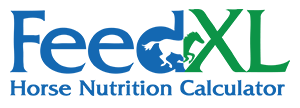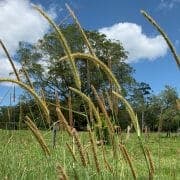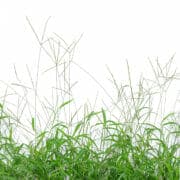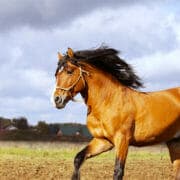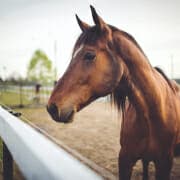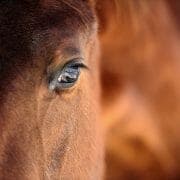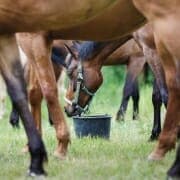Feeding the Laminitic Horse
Laminitis can be time consuming, painful for your horse and heartbreaking for you. A proper diet can make it a whole lot easier.
A majority of laminitis cases are due to insulin dysregulation. For this reason, a diet based on low non-structural carbohydrate (NSC; starch + sugars) forage is vital. Good quality protein is important for aiding in recovery, especially of the hoof. And meeting requirements for vitamins and minerals is also a must for general health and immune function.
The good news is, feeding a laminitic horse doesn’t have to be difficult. The following are some guidelines for making it easier; first is getting the basics right. Then we fine‐tune for weight changes. And finally, there are some tips on dealing with boredom and associated problems like hoof repair.
Getting the basics right
- A low NSC forage should make up most of the diet
- Never feed grain, grain by‐products or molasses
- Make sure the diet is balanced for vitamins and minerals
Base the diet on low NSC pasture or hay
All horse diets should be based on forage and the laminitic horse is no different. However, they need low NSC forages. There are a few ways you can give your horse access to low NSC forages. These are:
- Graze in the VERY early hours of the morning from 2 hours before until 2 hours after sunrise. This is when pasture NSC levels are lowest.
If you are unable to control the hours of the day your horse is allowed to graze, use a grazing muzzle to reduce your horse’s intake of pasture. - Feed hays that are typically low in NSC. These include mature or stemmy subtropical grass hays like Rhodes grass has and mature, stemmy or weather damaged lucerne hay.
- If you can’t access these kinds of hays, soak the hay you do have available in warm water for 30 minutes to 2 hours or in cold water for 2 to 10 hours*, draining and feeding. Do not give your horse access to the soaking water.
*In warm climates, avoid soaking for longer than 2 hours. - Avoid any hays that are known to have high levels of NSC, including ryegrass hay, oaten, wheaten or barley hay.
- Lucerne haylage or silage that has been produced specifically for horses is also a low NSC forage option (check there is no molasses added).
Never feed a grain or grain-by‐product-based feed
If your horse needs extra feed in addition to the low NSC forage you are feeding you must be very careful when selecting a suitable feed. You should never feed a laminitic horse with a feed that has any of the following ingredients:
- Oats, corn, wheat, rice, triticale, rye, barley or other cereal grains.
- Wheatfeed, millrun, millmix, broll, bran (rice or wheat), pollard, middlings or any other variation of these ingredients.
- Any form of steam flaked, micronised or extruded grain.
Read all labels and lists of ingredients carefully before buying a feed. And it is buyer beware. Many feeds that contain grain ‘by‐products’ like wheatfeed/millrun, bran or pollard advertise themselves as being ‘grain‐free’. This is grossly misleading and these feeds present as much danger to your laminitic horse as a feed that contains grain.
Other feeds claim to be ‘Low GI’, but again, if they contain any of the ingredients listed above, they should be avoided for laminitic horses. And finally, watch out for molasses added to feeds as this can make a feed high in sugar.
FeedXL will help you select suitable feeds that do not contain these ingredients by highlighting all unsuitable feeds for laminitic horses. Very few feeds are truly suitable for a laminitic horse.
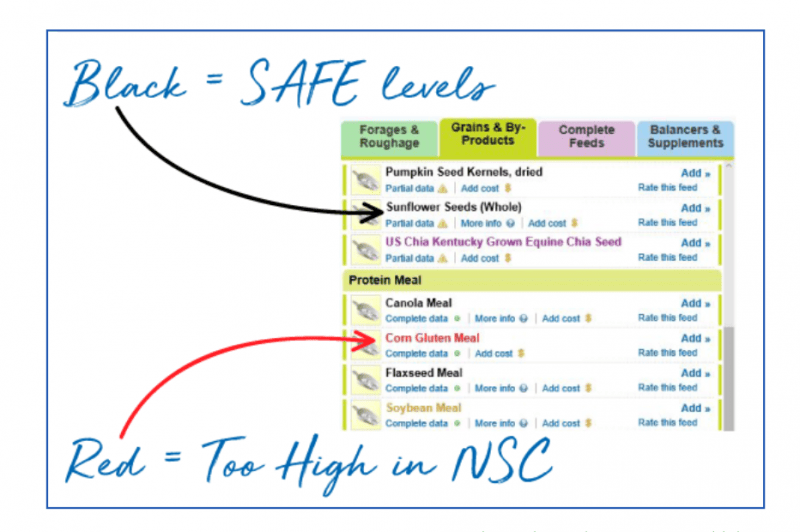
Make sure the diet is balanced!
It is very important to make sure the diet you are feeding your laminitic horse is balanced. Meeting the laminitic horse’s requirements for protein, amino acids, vitamins and minerals will help them recover from any previous bouts of laminitis, help them to resist other disease and infection and will keep them in good overall health with a strong immune system!
FeedXL will help you put a low NSC diet together that also meets requirements for protein, amino acids, minerals and vitamins.
Fine Tuning the diet
Feed according to your horse’s need to gain, hold or lose weight
Assess the body condition (fatness) of your horse and have a clear goal in mind as to whether you want the horse to gain, hold or lose weight. Click here to read our post ‘Why Body Condition Score’.
To gain weight
If the goal is to gain weight you should:
- Provide your horse with access to as much low NSC pasture or hay as he wants to eat (within reason, if he is consistently eating more than 3% of bodyweight you may need to limit the hay provided).
- Add some alfalfa/lucerne hay to the diet, feeding up to 4kg/day for a 500 kg horse (8.8 lb/day for an 1100 lb horse).
- Feed a low NSC complete feed at the recommended rates for your horse’s bodyweight and current activity (only use the complete feeds that are not highlighted red in FeedXL). Complete feeds will provide your horse with the calories, protein, vitamins and minerals he needs.
OR
Mix your own low NCS balanced feed by using high calorie unfortified ingredients like soybean or lupin hulls, sugarbeet pulp and copra meal. Then add your own vitamins and minerals via a low dose rate vitamin and mineral supplement and add protein from soybean or lupins.
If additional weight gain is needed add some oil to the diet. Start with ¼ of a cup per day and gradually increase the amount if required. Flaxseed (linseed) oil is a good choice for laminitics due to its high omega 3 content.
To maintain weight
To maintain your horse’s weight, you should:
- Allow the horse access to up to 2.5% of its bodyweight of low NSC forage (12.5 kg for a 500 kg horse) per day, including a small amount of alfalfa/lucerne hay.
- Balance the diet with a low dose rate vitamin and mineral supplement or balancer pellet and additional protein from soybean or lupins if your pasture or hay quality is poor.
- Monitor your horse closely. If he is not holding his bodyweight on this diet, increase the amount of alfalfa/lucerne you are feeding and reassess your horse. If he still isn’t holding condition, you can add high calorie unfortified ingredients like soybean or lupin hulls, sugarbeet pulp and copra meal to the existing diet.
OR
Switch to using a low NSC complete feed at the recommended rate for your horse.
To lose weight
If your horse needs to lose weight you must do it carefully, as forcing the laminitic into rapid weight loss can also stop them from healing their damaged hoof tissue and may cause other problems like hyperlipaemia. To gently encourage your horse to lose weight you should:
- Feed up to 2% of your horse’s body weight (10 kg/day for a 500 kg horse) per day as low quality, low NSC forage, including mature or stemmy subtropical grass hays and/or weather damaged alfalfa/lucerne hay.
- Balance the diet with a low dose rate vitamin and mineral supplement and good quality protein from full fat soybean. FeedXL can help you find an appropriate supplement using the ‘Find a Supplement to Fix This Diet’ feature.
- Constantly assess your horse’s body weight and adjust the diet according to the rate of weight loss. If your horse is not losing weight, reduce the amount of low sugar forage being fed to 1.5% of the horse’s current bodyweight (7.5 kg/day for a 500 kg horse; 16.5 lb for an 1100 lb horse). If this reduction doesn’t achieve the weight loss you want, reduce the amount of forage being fed to 1.5% of the horse’s ideal bodyweight.
Preventing boredom
To prevent boredom in these horses, make their forage hard to eat so it is more time consuming for them. One way you can do this is by using slow feeder hay nets. Or you can use forage feeding systems like the Savvy Feeder.
If you do feed hay out of hay nets you may need to dampen it down slightly to reduce dust. You should also feed their daily allocation of hay in 2 or 3 meals per day. When the horse is fully sound and able to exercise, a gentle exercise routine each day will also help them to lose weight and reduce their risk of further bouts of laminitis.
Assisting hoof repair
Feeding a low NSC diet will help to prevent further damage to your horse’s hooves. Providing high quality protein that contains good levels of the essential amino acids lysine and methionine (soybean contains the highest quality protein) as well as making sure your horse is getting its essential vitamins and minerals will give your horse the building blocks it needs to repair damaged hoof tissue.
If you find your horse’s hooves are taking a long time to respond to a well-balanced, low NSC diet, you may find the addition of biotin to the diet is helpful. For more information on the use of biotin to promote hoof growth, see our post Biotin: Should You Supplement?
By using FeedXL to balance your laminitic horse’s diet you will ensure you avoid unsuitable feeds and that you meet your horse’s requirements for good health and hoof repair.
For more detailed information on managing and feeding a laminitic horse, click here to get your copy of our FREE ebook ‘Your Guide to Feeding The Laminitic’.
Join FeedXL today and take control of your horse’s nutrition
Get EVEN MORE practical and personalised feeding guidance when you sign up to FEEDXL.
Do you have a question or comment? Do you need help with feeding?
We would love to welcome you to our FeedXL Horse Nutrition Facebook Group. Ask questions and have them answered by PhD and Masters qualified equine nutritionists and spend time with like-minded horse owners. It’s free!
Click here to join the FeedXL Horse Nutrition Facebook Group
